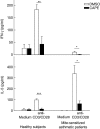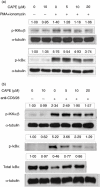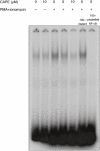Caffeic acid phenethyl ester inhibits nuclear factor-kappaB and protein kinase B signalling pathways and induces caspase-3 expression in primary human CD4+ T cells
- PMID: 20059479
- PMCID: PMC2857945
- DOI: 10.1111/j.1365-2249.2009.04067.x
Caffeic acid phenethyl ester inhibits nuclear factor-kappaB and protein kinase B signalling pathways and induces caspase-3 expression in primary human CD4+ T cells
Abstract
Caffeic acid phenethyl ester (CAPE), an active component in propolis, is known to have anti-tumour, anti-inflammatory and anti-oxidant properties. In this study, the effects of CAPE on the functions of primary human CD4+ T cells were evaluated in vitro. CAPE significantly suppressed interferon (IFN)-gamma and interleukin (IL)-5 production and proliferation of CD4+ T cells stimulated by soluble anti-CD3 and anti-CD28 monoclonal antibodies in both healthy subjects and asthmatic patients. CAPE inhibited nuclear factor (NF)-kappaB activation and protein kinase B (Akt) phosphorylation, but not p38 mitogen-activated protein kinase (MAPK) phosphorylation in T cells. CAPE also induced active caspase-3 expression in CD4+ T cells; CCR4+CD4+ T cells were more sensitive to CAPE induction than CXCR3+CD4+ T cells. Together, these results indicate that CAPE inhibits cytokine production and proliferation of T cells, which might be related to the NF-kappaB and Akt signalling pathways, and that CCR4+CD4+ T cells are more sensitive to CAPE inhibition. This study provides a new insight into the mechanisms of CAPE for immune regulation and a rationale for the use of propolis for the treatment of allergic disorders.
Figures







Similar articles
-
Caffeic acid phenethyl ester attenuates lipopolysaccharide-stimulated proinflammatory responses in human gingival fibroblasts via NF-κB and PI3K/Akt signaling pathway.Eur J Pharmacol. 2017 Jan 5;794:61-68. doi: 10.1016/j.ejphar.2016.11.003. Epub 2016 Nov 7. Eur J Pharmacol. 2017. PMID: 27832944
-
The effect of caffeic acid phenethyl ester on the functions of human monocyte-derived dendritic cells.BMC Immunol. 2009 Jul 16;10:39. doi: 10.1186/1471-2172-10-39. BMC Immunol. 2009. PMID: 19604415 Free PMC article.
-
Caffeic acid phenethyl ester promotes anti-inflammatory effects by inhibiting MAPK and NF-κB signaling in activated HMC-1 human mast cells.Pharm Biol. 2014 Jul;52(7):926-32. doi: 10.3109/13880209.2013.865243. Pharm Biol. 2014. PMID: 24920235
-
Recent progresses in the pharmacological activities of caffeic acid phenethyl ester.Naunyn Schmiedebergs Arch Pharmacol. 2021 Jul;394(7):1327-1339. doi: 10.1007/s00210-021-02054-w. Epub 2021 Jan 25. Naunyn Schmiedebergs Arch Pharmacol. 2021. PMID: 33492405 Review.
-
Caffeic acid phenethyl ester: its protective role against certain major eye diseases.J Ocul Pharmacol Ther. 2014 Nov;30(9):700-8. doi: 10.1089/jop.2014.0046. Epub 2014 Aug 6. J Ocul Pharmacol Ther. 2014. PMID: 25100535 Review.
Cited by
-
Caffeic acid phenethyl ester attenuates Enterococcus faecalis infection in vivo: antioxidants and NF-κB have a protective role against stomach damage.J Med Life. 2024 Jun;17(6):574-581. doi: 10.25122/jml-2023-0544. J Med Life. 2024. PMID: 39296435 Free PMC article.
-
Propolis changes the anticancer activity of temozolomide in U87MG human glioblastoma cell line.BMC Complement Altern Med. 2013 Feb 27;13:50. doi: 10.1186/1472-6882-13-50. BMC Complement Altern Med. 2013. PMID: 23445763 Free PMC article.
-
Caffeic Acid Phenethyl Ester (CAPE) Induced Apoptosis in Serous Ovarian Cancer OV7 Cells by Deregulation of BCL2/BAX Genes.Molecules. 2020 Jul 31;25(15):3514. doi: 10.3390/molecules25153514. Molecules. 2020. PMID: 32752091 Free PMC article.
-
Caffeic acid phenethyl ester is protective in experimental ulcerative colitis via reduction in levels of pro-inflammatory mediators and enhancement of epithelial barrier function.Inflammopharmacology. 2018 Apr;26(2):561-569. doi: 10.1007/s10787-017-0364-x. Epub 2017 May 20. Inflammopharmacology. 2018. PMID: 28528363 Free PMC article.
-
Rubus urticifolius Compounds with Antioxidant Activity, and Inhibition Potential against Tyrosinase, Melanin, Hyaluronidase, Elastase, and Collagenase.Pharmaceuticals (Basel). 2024 Jul 13;17(7):937. doi: 10.3390/ph17070937. Pharmaceuticals (Basel). 2024. PMID: 39065787 Free PMC article.
References
-
- Larche M. Immunoregulation by targeting T cells in the treatment of allergy and asthma. Curr Opin Immunol. 2006;18:745–50. - PubMed
-
- Williams CM, Galli SJ. The diverse potential effector and immunoregulatory roles of mast cells in allergic disease. J Allergy Clin Immunol. 2000;105:847–59. - PubMed
-
- Gleich GJ, Flavahan NA, Fujisawa T, Vanhoutte PM. The eosinophil as a mediator of damage to respiratory epithelium: a model for bronchial hyperreactivity. J Allergy Clin Immunol. 1988;81:776–81. - PubMed
-
- Bochner BS, Busse WW. Allergy and asthma. J Allergy Clin Immunol. 2005;115:953–9. - PubMed
-
- Larche M, Robinson DS, Kay AB. The role of T lymphocytes in the pathogenesis of asthma. J Allergy Clin Immunol. 2003;111:450–63. - PubMed
Publication types
MeSH terms
Substances
LinkOut - more resources
Full Text Sources
Other Literature Sources
Medical
Research Materials

